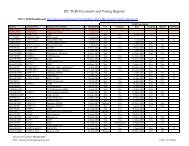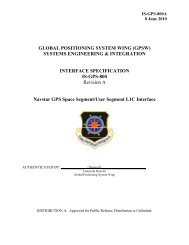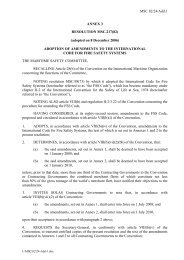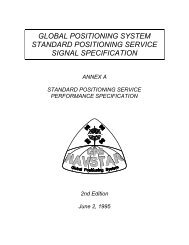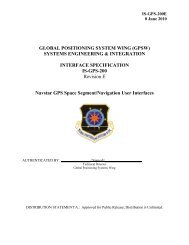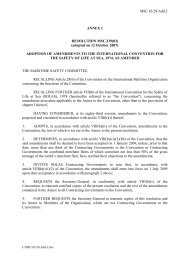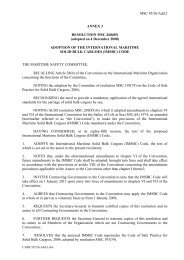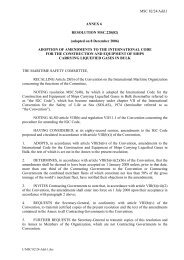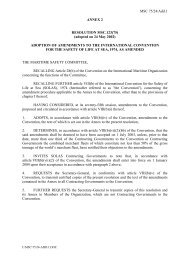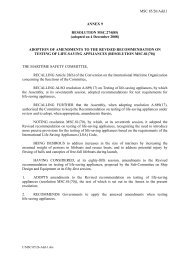The LORAN-C System - US Coast Guard Navigation Center
The LORAN-C System - US Coast Guard Navigation Center
The LORAN-C System - US Coast Guard Navigation Center
You also want an ePaper? Increase the reach of your titles
YUMPU automatically turns print PDFs into web optimized ePapers that Google loves.
ates. <strong>The</strong> type of blanking used for dual-rated stations is shown inthe data sheets given in Appendix B.<strong>The</strong> stations in the loran chain transmit in a fixed sequence whichensures that TDs can be measured throughout the coverage area. <strong>The</strong>length of time in usec over which this sequence of transmissions fromthe master and the secondaries takes place is termed the GroupRepetition Interval (GRI) of the chain.All Loran-C chains operate on the same frequency (100 kHz), but aredistinguished by the GRI of the pulsed transmissions. GRIs for eachchain, together with CDs and EDs for each secondary in the chain arealso given in Appendix B.Chain Configuration<strong>The</strong> physical locations of the master and secondary transmitters (amongother factors) is an important determinant of both the accuracy andcoverage area of the Loran-C chain. Although the configuration (sitepattern of the transmitters) of each loran chain differs, it isconvenient to group these configurations into three generic categories;the Triad (master and two secondaries), the Wye (master and threesecondaries in a spatial arrangement roughly resembling the letter Y),and the Star (master and four or more secondaries roughly resembling astar in appearance), as illustrated in Figure II_1. For example, theIcelandic (9980) and Labrador (7930) chains are illustrations ofTriads, the North Pacific (9990) is a Wye, and the NE<strong>US</strong> (9960) is in aStar configuration.<strong>The</strong>se generic configuration categories are only approximatedescriptions the NE<strong>US</strong> (9960) chain, for example, would be classified asa star in this taxonomy but, as can be seen from Figure II-2 6 , theresemblance is not literal. Interestingly enough, each transmitter inthe 9960 chain is dual rated; the Zulu secondary is discussed above,the master, located in Seneca, NY, also serves as the X-ray secondaryfor the Great Lakes (8970) chain, the Yankee secondary, located inCarolina Beach, NC, also serves as the Zulu secondary for the SE<strong>US</strong>(7980) chain, the X-ray secondary, located in Nantucket, MA, alsoserves as X-ray secondary for the Canadian East <strong>Coast</strong> (5930) chain, andfinally, the Whiskey secondary, located in Caribou, ME, also serves asthe master station for the Canadian East <strong>Coast</strong> (5930) chain.<strong>The</strong> chain configuration is an important determinant of the coverage andnavigational accuracy of the chain. Three common configurations in useare the Triad, Wye, and Star.<strong>The</strong> coverage area (discussed in Chapter III) for the NE<strong>US</strong> (9960) chainis also shown in Figure II_2 enclosed by the long dashed lines. Inthis chain the dimensions of the coverage area are each nearly 1,000 NMin length an area several hundred thousand square miles in extent. Offshorecoverage extends several hundred miles.Other Definitions<strong>The</strong> geographic line (technically the arc segment of the great circle)connecting the master and each secondary is termed the baseline for themaster-secondary pair. <strong>The</strong> length of the baseline (in nautical miles)varies with the chain and the individual master-secondary pair, but istypically several hundred miles. Other points on this same great
circle containing the baseline (i.e., on the extension of the baselinebeyond the two stations joined) are part of what is termed the baselineextension. As noted below, navigational use of a particular mastersecondarypair in the area of the baseline extension is problematic.(Baseline extensions are shown on nautical charts, as discussed inChapter VI.)Key technical terms defined in this section include GRI, ED, CD,baseline, baseline travel time, and baseline extension.Hyperbolic <strong>System</strong>s: A Second LookAs noted in Chapter I, hyperbolic navigation systems function bymeasuring the time differences in reception of signals from the masterand secondary transmitters. This chapter expands upon the basic idea ofthe hyperbolic system with particular emphasis on the Loran-C system.This section is fairly technical, and may be skipped by the readeruninterested in such detail. Overall, the key technical points aresimple enough. First, the locus of points of constant difference indistance from two stations is described by a mathematical functiontermed a hyperbola. Second, the same is true for time differences(assuming a constant propagation velocity). <strong>The</strong>refore, LOPs of constantTDs are likewise hyperbolas. Finally, the real world is slightly morecomplex than the assumption of a constant propagation velocity wouldindicate. Precise calculations of the physical location of loran LOPsrequire a series of correction factors to be applied to account for thefact that loran waves slow down over seawater or land (compared topropagation through the atmosphere).Hyperbolic Geometry On a PlaneTo be concrete, suppose that (as some ancients did) the earth were aflat plane, defined by the usual rectangular (X, Y) coordinate system,where the units of the X and Y axis are in nautical miles from anorigin located at the point (0,0). Now suppose that two loran stationsare located on this lattice, a master station located at the pointM=(Xm, Ym) = (-200, 0) along the X-axis, and an X-ray secondary stationat the point S = (Xs, Ys) (200, 0)-some 400 NM to the right along theX-axis. Consider an arbitrary point A = (Xa, Ya) on the lattice. Fromelementary plane geometry, the distance (in nautical miles) from pointA to the master M, denoted d am , is:d am = ((Xa - Xm) 2 + (Ya - Ym) 2 ), 0.5 (II-1)Or, in terms of the defined location of the master station, equation(II_1) reduces to:d am = ((Xa + 200) 2 + Y 2 a). 0.5 (II-2)Likewise, the distance from point A to the secondary, denoted d as , isgiven by:d as = ((x a -200) 2 + y 2 a). 0.5 (II-3)Finally, the difference between these distances, denoted Z, is givenby:
Z = d am - d as(II-4)Z = ((Xa + 200) 2 + Y 2 a) .0.5 -((X a - 200) 2 + y 2 a) .0.5 (II-5)Figure II_3 shows how this distance difference function, Z, varies withthe location of the point A in the plane. (This figure is truncated atZ = -350 (point A 350 miles chosen to the master than to the secondary)and at Z = 350 (point A 350 miles closer to the secondary than to themaster).A more typical presentation of this difference function is to takeslices of this surface at various values for Z. <strong>The</strong>se slices (referredto as level curves, or constant differential distance contours) areshown in Figure II_4. Mathematically, these curves are hyperbolas.On a sphere (rather than the plane used in Figures II_3 and II_4) thesewould be spherical hyperbolas, while on the slightly nonspherical earththese would be spheroidal hyperbolas. (Readers accustomed to looking atrelatively large-scale loran overprinted nautical charts may besurprised at the curvature of the LOPs shown in Figure II_4. Over theshort distances covered by a large-scale charts the curvature of theloran LOPs is much less apparent.)<strong>The</strong> locus of points that have a constant difference in distance from amaster and secondary station describes a mathematical curve termed ahyperbola.To illustrate, suppose that point A were located at the point shown inFigure II_4, A = (271.9, 200). From equation (II_3), the distance frompoint A to the secondary would be approximately 212.5 nautical miles.And, from equation (II_2), the distance from point A to the masterwould be approximately 512.5 nautical miles. Point A, therefore, is 300miles closer to the X-ray secondary than to the master. Figure II_4also shows the locus of all such points 300 miles closer to thesecondary than to the master this contour is a hyperbola labeled withthe number 300. Thus, if we could determine that we were 300 milescloser to the secondary than to the master, we would be locatedsomewhere along this hyperbolic LOP (300).<strong>The</strong>se hyperbolic LOPs are all curved, with the exception of the LOPwhere the difference in distance is exactly zero. This is termed thecenterline of the system, and is a straight line (rather than a curve)that bisects the baseline. On the curved surface of the earth thecenterline is actually a great circle oriented at right angles to thebaseline. <strong>The</strong> baseline extension is also shown in Figure II_4.Equivalence Between Distance and Time<strong>The</strong> contours in Figure II_4 are labeled in terms of distance, but(assuming a constant speed of signal propagation) could equally well be
labeled in terms of time difference (TD). All that is necessary tocalculate the theoretical time difference for any point in Figure II_4is the speed of signal propagation and the CD of the X-ray secondary.To a first approximation, 7 loran signals travel at the speed of light ittakes approximately 6.18 usec for the signal to travel one nauticalmile.Now consider point A again in Figure II_4. <strong>The</strong> distance from the masterto point A is 512.5 NM, so the signal from the master would takeapproximately 6.18 (512.5) = 3,167 usec to reach a vessel at point A.<strong>The</strong> arrival of this signal starts the TD measurement in the vesselsloran receiver. When will the signal from the secondary arrive? Recallthat the secondary transmits after an emission delay, equal to thebaseline travel time plus the secondary coding delay. <strong>The</strong> master and X-ray secondary are 400 miles apart in this illustration, so the baselinetravel time (or baseline length in usec) is approximately 6.18 (400) =2,472 usec. Assuming a CD for this secondary of 11,000 usec, 8 the X-ray secondary would transmit 2,472 + 11,000 = 13,472 usec after themaster. This signal must travel approximately 212.5 NM to reach thevessel at point A, a travel time of 6.18 (212.5) = 1,313 usec. Thus, inthis example, the signal from X-ray would arrive 13,472 + 1,313 =14,785 usec after the master transmission. <strong>The</strong> observed TD at thevessel is this time, 14,785 usec, minus the time that the master signalarrives at the vessel, previously calculated as 3,167 usec. <strong>The</strong>theoretical TD (based upon these assumptions) at the vessel is 14,785 -3,167 = 11,618 usec. This calculation is summarized in Table II_2 andthe time lines are shown diagrammatically in Figure II_5.Loran LOPs can be displayed as distance differences or equivalently asTDs. Because TDs are measured on the receiver, these are shown on loranoverprinted charts.Returning now to Figure II_4, the LOP on which point A is located couldbe labeled as 300 NM or equivalently as 11,618 usec. Any point on thisLOP is 300 miles closer to the X-ray secondary. Likewise (given theassumed CD), at any point on this same line, the theoretical TD wouldalso be 11,618 usec. Because it is the TD rather than the difference indistance that is measured, it is much more convenient to label theloran overprinted nautical chart with the TD. More typically the LOPsshown on a loran overprinted chart would be evenly spaced every 5 or 10usec. (See Chapter VI.)With a few added complexities (discussed below) to account for anonconstant speed of signal propagation, this is the exact procedureused for calculation of the theoretical location of the TDs on thenautical chart.Though tedious, calculation of the location of lines of constant timedifference is a straightforward exercise in geometry. To a firstapproximation, lines of constant difference in distance from twostations are also lines of constant TD._More Exact Calculations<strong>The</strong> foregoing calculations assume a constant speed of propagation ofthe Loran-C signal. This simplifying approximation is very nearly
correct, but would result in position inaccuracies that exceed thedesigned accuracy limits of the Loran-C system. <strong>The</strong>refore, it isnecessary to refine this approximation.Conventionally, this refinement process amounts to applying variouscorrections to either the speed of propagation of the loran signal orequivalently the predicted time required for the signal to traverse aspecified distance. Typically three correction factors, termed phasefactors, are applied. <strong>The</strong>se are defined and summarized in Table II_3.Primary Phase Factor (PF)<strong>The</strong> first of these factors is termed the primary phase factor (PF),and accounts for the fact that the speed of propagation of the signalin the atmosphere is slightly slower than in free space (vacuum).According to Bowditch, the speed of light in vacuum is 161,875 NM/sec(equivalent to 6.17761 usec/NM), whereas in the atmosphere the speed isslowed slightly to 161,829 NM/sec (equivalent to 6.17936 usec/NM). Thisspeed difference is related to the fact that the atmospheric index ofrefraction is slightly greater than unity. All Loran-C overprintedcharts and loran receivers incorporate the PF correction.Secondary Phase Factor<strong>The</strong> second correction factor, termed the secondary phase factor (SF),reflects the fact that the loran groundwave is further retarded whentraveling over seawater as opposed to through the atmosphere. When theLoran-C signals are transmitted, part of the electromagnetic wave is inthe air, and part penetrates the earth’s surface. Seawater is not asgood a electrical conductor as air, so the signals are slowed as theytravel over seawater. <strong>The</strong> amount of time required for travel over aspecified distance will exceed that calculated using the PF by anamount equal to the SF. SF is applied as a correction term to therequired travel time rather than as an adjustment to the propagationspeed of the signals. Several equations for SF have been proposed, suchas the so-called Harris polynomials shown below which relate the SF tothe distance traveled, d (in statute miles):Table II_4 shows the PFs and SFs (from equation II_7)) applied to theapproximate calculation given in Table II_4. For this example, the moreexact calculation differs little from the approximate calculation, but(depending on the position within the coverage area) these differencescould be numerically larger. As with PFs, SFs are incorporated into allLoran-C overprinted charts and commercial receivers.Additional Secondary Phase Factor (ASF)Application of the PF and SF enables calculation or loran TDs over anall-seawater path. In practice (see, e.g., Figure II_2), loran signalstravel over a mixed path; partially over land of variousconductivities, and partially over seawater. <strong>The</strong> correction arisingfrom the additional retardation of the signal is termed the additionalsecondary factor (ASF). ASF is the least predictable of the phasefactors. Many things affect the value of ASF along a signaltransmission path, including conductivity of the soil (which itself
varies with the temperature and water content of the soil), distancetraveled over land, etc. <strong>The</strong> accuracy of a conversion from Loran-C TDsto latitude/longitude (discussed in Chapters III and IV) dependscritically on the value of ASF used in the mathematical signalpropagation model.ASF is generally calculated by considering the overall path as separatesegments, each having a uniform conductivity value. <strong>The</strong> ASF of eachsegment can be computed and then the composite ASF is derived. Apopular method of doing this is called Millingtons method, reviewed inAppendix F. Another method of determining ASF is to measure the TDs ata point, compute the TDs at the same point using a mathematical modelwhich assumes an all seawater propagation path, and then determine thedifference between the measured and computed TDs. A finite number ofsuch measurements can be made and extrapolated to cover the areasbetween measurements. ASFs measured in this fashion tend to be moreaccurate than those computed by Millingtons method. ASFs at a fixedpoint in the coverage area actually vary with time. To achieve optimumaccuracy these temporal ASF changes must be taken into account. ASFvariations with time are chiefly caused by changes in soil conductivitydue to seasonal weather variations, day/night temperature variations,and local weather activity (thunderstorms, droughts, etc.).In summary, speed and phase of Loran-C signals are affected by severalphysical parameters. <strong>The</strong> primary, secondary, and additional secondaryphase factors (PF, SF, and ASF) account for changes due to air,seawater, and land paths, respectively.ASF TablesAs can be seen from Appendix F, computation of even average (let alonetime varying) ASFs is quite tedious, and requires substantial data basedescribing the relevant conductivity of land or mixed land/water paths.Fortunately these ASFs are incorporated into most Loran-C overprintedcharts and also many Loran-C receivers.Although ASF corrections are incorporated into most (but not all)modern Loran-C receivers, the user should remember that the governmentis responsible for the accuracy of the ASFs incorporated into ASFtables (see below) and loran overprinted charts. <strong>The</strong> government is notresponsible and cannot guarantee the quality of the ASF databases usedin Loran-C receivers, these are strictly the responsibility of themanufacturer.Additionally, ASFs can be found in a set of tables, called Loran-CCorrection Tables, prepared and published by the Defense MappingAgency, Hydrographic/Topographic <strong>Center</strong> (DMAHTC). <strong>The</strong>se tables arepublished in a series of volumes, one for each loran chain. Each volumeis organized into a set of pages for each station pair (master andsecondary) or rate within the chain. Further, each page of correctionsin the table covers an area three degrees in latitude by one degree oflongitude. An index permits rapid determination of the appropriate pagein the table to find ASFs of interest.
Table II_5 provides an excerpt of a Loran-C Correction Table for theNE<strong>US</strong> (9960) chain and master-Whiskey station pair. This page covers anarea off the mouth of the Delaware Bay between latitudes of 36 0' N and39 0' N, and longitudes 74 0' W and 75 0' W. Large land bodies andareas outside the CCZ are represented by blank spaces on the pages (seeTable II_5).ASF corrections given in this table are to be applied to the measuredTDs, and can be positive or negative. Negative values are prefixed witha minus (_) sign, while positive values are shown without sign. In somecases, a negative sign precedes a zero value; this results fromrounding off a value slightly less than zero and indicates the trend ofthe correction.Use of TablesAccording to DMAHTC,ASF tables are published primarily for precision navigators who utilizeelectronic computers to convert Loran-C time differences to geographiccoordinates.<strong>The</strong>se tables can also be used by navigators using manual plottingmethods for Loran-C navigation.ASF corrections are typically small (no more than 4 usec), but can besignificant for precise navigation, a point illustrated below.<strong>The</strong> ASF correction table can be entered by using the vessels deadreckoning (DR) position, indicated loran position, or positiondetermined by other means. ASFs are added algebraically to the measured(observed) TD of the station pair. For example, suppose that the vesselwere located at the approximate position 39 0' N and 74 30' W, and thatthe ASF for the Whiskey station pair were desired. From Table II_5 itcan be seen that the ASF is _0.9 usec. Thus, in this instance 0.9 usecshould be subtracted from the observed TD to obtain a corrected TD.ASF corrections should be used with caution for areas within tennautical miles of land (coastline effect) and should not be used withcharts that provide a corrected lattice.Care should be taken to ensure that the correct table (hence chain) isused, and that the correction station pair is considered. Table II_6,for example, shows how the ASF correction (for the same latitude andlongitude used in the above illustration) varies with the secondarystation and chain. Assuming the location given, the correctionappropriate for the X-ray secondary in the 9960 chain would be 2.9usec, compared to only 0.3 usec if the 8970 chain were used. It isparticularly important to use the right table (correct chain andstation pair) when determining ASF corrections.Lest the reader conclude that all this emphasis on refined calculationsis much ado about nothing, the accuracy of the predicted LOP is a keydeterminant of the accuracy of the loran position. Loran-C accuracy and
ionosphere. <strong>The</strong> reflection height will vary from approximately 60kilometers during daylight, to approximately 90 kilometers at night.From the geometry of the reflection, it is obvious that the skywavesignal must travel a longer distance to reach an observer and willarrive after the corresponding groundwave generally after a time lapseof from 35 usec to 1000 usec after the groundwave (depending upon theheight of the reflecting layer in the ionosphere). Because skywaves donot travel over the surface of the earth, these are not attenuated tothe same extent as the groundwave. In consequence, at long distances,the skywave signal may be very much stronger than the groundwavesignal. <strong>The</strong> skywave can cause distortion of the received groundwavesignal in the form of fading and pulse shape changes generally giventhe name skywave contamination.Although it is possible to develop position information from skywavesignals (and, indeed, skywaves were used in early loran), the mostaccurate navigation requires the use of the loran groundwave. (Use ofskywaves for navigation is discussed briefly in Appendix H.)<strong>The</strong> reason why groundwaves are preferred over skywaves for accuratenavigation is that the propagation conditions (in the ionosphere) arenot stable, but change from day-to-day and even hour-to-hour, whichvastly complicates the problem of prediction of arrival times forskywaves. <strong>The</strong> skywave, therefore, is generally regarded as anuisance, and the Loran-C system has been designed in part to minimizethe possible influence of skywaves on groundwave reception andtracking.Pulse Architecture andRelated Technical MattersIt is noted above that the Loran-C system uses pulsed transmission ninepulses for the master and eight pulses for the secondary transmissions.Figure II_7 shows this overall pulse pattern for the master and threesecondary transmitters (X-ray, Yankee, and Zulu). Shown also in FigureII_7 is an exploded view of the Loran-C pulse shape. It consists ofsine waves within an envelope that might loosely be described asteardrop shaped, and is referred to technically as a t-squared pulse.(<strong>The</strong> equation for the envelope is also included in Figure II_7.) Thispulse will rise from zero amplitude to maximum amplitude within thefirst 65 usec and then slowly trails off or decays over a 200_300 usecinterval. <strong>The</strong> pulse shape is designed so that 99% of the radiated poweris contained within the allocated frequency band for Loran-C of 90 kHzto 110 kHz.<strong>The</strong> rapid rise of the pulse allows a receiver to identify oneparticular cycle of the 100 kHz carrier. Cycles are spacedapproximately 10 usec apart. <strong>The</strong> third cycle of this carrier within theenvelope is used when the receiver matches the cycles. <strong>The</strong> third zerocrossing (termed the positive 3rd zero crossing) occurs at 30 usec intothe pulse. This time is both late enough in the pulse to ensure anappreciable signal strength and early enough in the pulse to avoidskywave contamination from those skywaves arriving close after thecorresponding groundwave.
Phase CodingWithin each pulse group from the master and secondary stations, thephase of the radio frequency (RF) carrier is changed systematicallyfrom pulse-to-pulse in the pattern shown in Figure II_8. This procedureis known as phase coding. <strong>The</strong> patterns “A” and “B” alternate insequence. <strong>The</strong> pattern of phase coding differs for the master andsecondary transmitters. Thus, the exact sequence of pulses is actuallymatched every two GRIs an interval known as a phase code interval(PCI). 9Phase coding enables the identification of the pulses in one GRI fromthose in an earlier or subsequent GRI. Just as selection of the pulseshape and standard zero crossing enable rejection of certain skywaves,phase coding enables rejection of others; late airway skywaves willhave a different phase code from the groundwave. Because the master andsecondary signals have different phase codes, these can bedistinguished by the loran receiver. Phase coding also offers othertechnical benefits.Blink Coding<strong>The</strong> Loran-C system also permits the secondary transmissions (morespecifically the first two pulses of the secondary pulse group) toblink.This secondary blink can be detected by the loran receiver, and isused to warn users that the loran signal is unreliable and should notbe used for navigation. (<strong>The</strong> specifics of the blink display differ fromreceiver-to-receiver in some cases a blink alarm on the receiver willlight, in others the displayed TDs simply blink on and off.) Blinkalarms warn that the signal power, TD, or ECD is out-of-tolerance (OOT)and/or that an improper phase code or GRI is being transmitted. <strong>The</strong>blink coding contributes significantly to the integrity of the loransystem.When secondary blink is enabled, the first two pulses of the affectedsecondary are blinked at a four-second cycle; about 3.6 seconds off andabout 0.4 seconds on. Secondary blink is used to advise users ofpotential problems. <strong>The</strong> loran system also has the capability to blinkthe master signal. Master blink is used for internal communications,and does not indicate a system malfunction. Most modern user receiversare not programmed to detect master blink.Concluding CommentsTable II_7 summarizes some of the key technical features of the Loran-Csystem and reasons for their inclusion. At a detailed level, thissystem is highly complex, but these complexities are essential tocreate a highly accurate, reliable, and easy to use long-range system.




